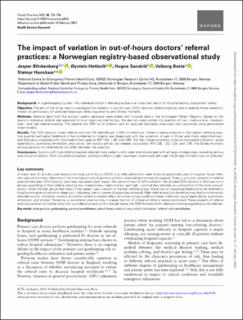| dc.description.abstract | Abstract Background In a gatekeeping system, the individual doctor’s referral practice is an important factor for hospital activity and patient safety. Objective The aim of the study was to investigate the variation in out-of-hours (OOH) doctors’ referral practice, and to explore these variations’ impact on admissions for selected diagnoses reflecting severity, and 30-day mortality. Methods National data from the doctors’ claims database were linked with hospital data in the Norwegian Patient Registry. Based on the doctor’s individual referral rate adjusted for local organizational factors, the doctors were sorted into quartiles of low-, medium-low-, medium-high-, and high-referral practice. The relative risk (RR) for all referrals and for selected discharge diagnoses was calculated using generalized linear models. Results The OOH doctors’ mean referral rate was 110 referrals per 1,000 consultations. Patients seeing a doctor in the highest referring practice quartile had higher likelihood of being referred to hospital and diagnosed with the symptom of pain in throat and chest, abdominal pain, and dizziness compared with the medium-low quartile (RR 1.63, 1.49, and 1.95). For the critical conditions of acute myocardial infarction, acute appendicitis, pulmonary embolism, and stroke, we found a similar, but weaker, association (RR 1.38, 1.32, 1.24, and 1.19). The 30-day mortality among patients not referred did not differ between the quartiles. Conclusions Doctors with high-referral practice referred more patients who were later discharged with all types of diagnoses, including serious and critical conditions. With low-referral practice, severe conditions might have been overlooked, although the 30-day mortality was not affected. | en_US |

